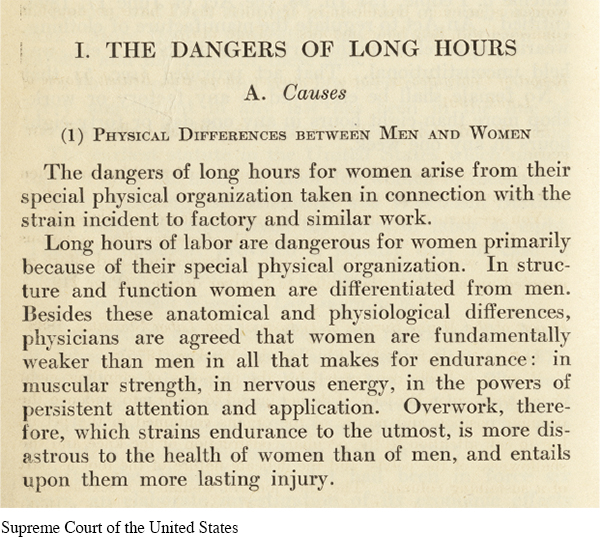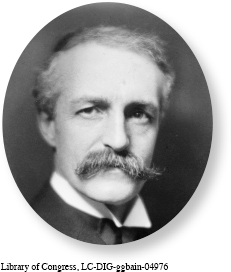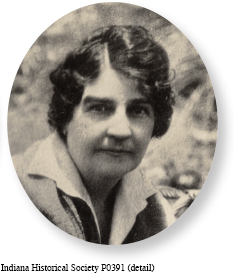Introduction to Chapter 19
19
Progressivism and the Search for Order
1900–1917
WINDOW TO THE PAST
Louis D. Brandeis, Brief for Defendant in Error, Muller v. Oregon 1908
This image is of the brief submitted by Louis D. Brandeis to the U.S. Supreme Court in the landmark case of Muller v. Oregon (1908). Going beyond legal precedents, the brief marshaled medical and social science evidence about the dangers of long working hours for women outside the home. The brief also raised questions about the best strategy to pursue equality for women. Legal cases like this make excellent sources for exploring social and political history. To discover more about what this primary source can show us, see Document 19.7.

LEARNING OBJECTIVES
After reading this chapter you should be able to:
Compare and contrast progressivism with Populism.
Identify the problems humanitarian progressives tried to address.
Discuss the reasons progressives engaged in moral reform and how their views of immigrants shaped their efforts.
Evaluate how the notions of efficiency, openness, and accountability influenced the progressives’ approach to political and environmental reform.
Contrast the ways in which the federal government handled progressive reform during the administrations of Presidents Theodore Roosevelt, William Howard Taft, and Woodrow Wilson.
AMERICAN HISTORIES

Gifford Pinchot grew up on a Connecticut estate where he learned to hunt, fish, and enjoy nature. Yet Pinchot rejected a life of leisure and instead sought to make his mark through public service by working to conserve and protect America’s natural resources. After graduating from Yale in 1889, Pinchot had to study forestry abroad. No American university offered a forestry program, reflecting the predominant view that, for all practical purposes, the nation’s natural resources were unlimited. As a consequence, Pinchot took courses at the French National School of Forestry, where the curriculum treated forests as crops that needed care and replenishing.
By the time Pinchot returned in 1890, many Americans had begun to see the need to conserve the nation’s natural resources and protect its wild spaces. Drawing on his scientific training and his experiences in Europe, Pinchot advocated the use of natural resources by sportsmen and businesses under carefully regulated governmental authority. Appointed to head the Federal Division of Forestry in 1898, Pinchot found a vigorous ally in the White House when Theodore Roosevelt took office in 1901. In 1907 Pinchot began to speak of the need for conservation, which he defined as the use of America’s natural resources “for the benefit of the people who live here now.” This use of resources included responsible business practices in industries such as logging and mining.

Not all environmentalists agreed. In contrast to Pinchot, author and nature photographer Geneva (Gene) Stratton-Porter focused her energies on preservation, the protection of public land from any private development. Born in 1863 in Wabash County, Indiana, Stratton-Porter grew up roaming through fields, watching birds, and observing “nature’s rhythms.” After marrying in 1886, Stratton-Porter took up photography and hiked into the wilderness of Indiana to take pictures of wild birds.
Stratton-Porter built a reputation as a nature photographer. She also published a series of widely read novels and children’s books that revealed her vision of the harmony between human beings and nature. She urged readers to preserve the environment so that men and women could lead a truly fulfilling existence on earth and not destroy God’s creation. One area on which she and Pinchot agreed was support for national parks.
The American histories of Gifford Pinchot and Gene Stratton-Porter reveal the efforts of just two of the many individuals who searched for ways to control the damaging impact of modernization on the United States. From roughly 1900 to 1917, many Americans sought to bring some order out of the chaos accompanying rapid industrialization and urbanization. Despite the magnitude of the issues, those who believed in the need to combat the problems of industrial America possessed an optimistic faith—sometimes derived from religious principles, sometimes from a secular outlook—that they could relieve the stresses and strains that modern life brought. Such people were not bound together by a single, rigid ideology. Instead, they were united by faith in the notion that if people joined together and applied human intelligence to the task of improving the nation, progress was inevitable. So widespread was this hopeful conviction that we call this period the Progressive Era.
In pursuit of progress and stability, some reformers tried to control the behavior of groups they considered a threat to the social order. Equating difference with disorder, many progressives tried to impose white middle-class standards of behavior on immigrant populations. Some sought to eliminate the “problem” altogether by curtailing further immigration from southern and eastern Europe. Others advocated birth control as a means to preserve the lives of childbearing women, but also to promote ethnic and racial engineering. In addition, progressives fought for women’s suffrage, consumer protection, regulation of business, and good government reform. Many white progressives, particularly in the South, favored racial segregation and disfranchisement of African Americans. At the same time, however, black progressives and their white allies created organizations dedicated to securing racial equality. Despite their disparate and sometimes conflicting aims, progressives maintained a passion for change as a means of improving the nation.
Exploring American HistoriesPrinted Page 615
Exploring American Histories Value EditionPrinted Page 453
Chapter Timeline